日本食品添加剂标准中文
- 格式:xls
- 大小:180.00 KB
- 文档页数:22
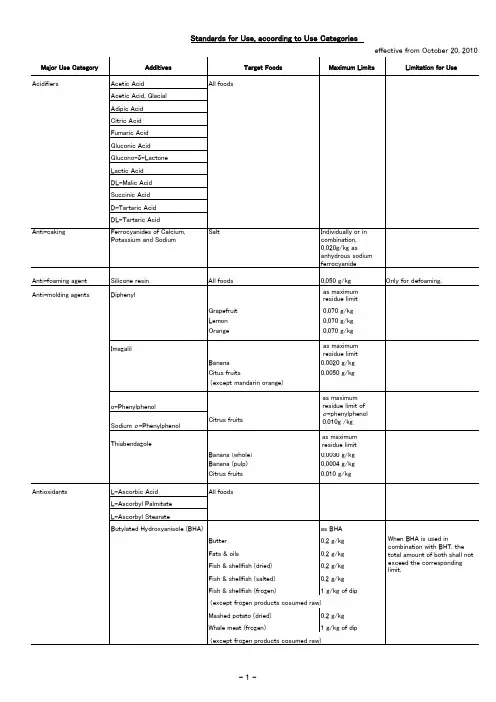
Major Use Category AdditivesTarget FoodsMaximum LimitsLimitation for UseAcidifiersAcetic Acid All foodsAcetic Acid, Glacial Adipic Acid Citric Acid Fumaric Acid Gluconic Acid Glucono-δ-Lactone Lactic Acid DL-Malic Acid Succinic Acid D-Tartaric Acid DL-Tartaric AcidAnti-cakingFerrocyanides of Calcium,Potassium and SodiumSaltIndividually or in combination,0.020g/kg asanhydrous sodium ferrocyanide Anti-foaming agent Silicone resin All foods0.050 g/kg Only for defoaming.Anti-molding agentsDiphenylGrapefruit 0.070 g/kg Lemon 0.070 g/kg Orange0.070 g/kg ImazalilBanana 0.0020 g/kg Citus fruits0.0050 g/kg(except mandarin orange)o-Phenylphenol Sodium o -Phenylphenol Citrus fruitsThiabendazoleBanana (whole)0.0030 g/kg Banana (pulp)0.0004 g/kg Citrus fruits0.010 g/kgAntioxidantsL-Ascorbic Acid All foods L-Ascorbyl Palmitate L-Ascorbyl StearateButylated Hydroxyanisole (BHA)as BHA Butter 0.2 g/kg Fats & oils0.2 g/kg Fish & shellfish (dried)0.2 g/kg Fish & shellfish (salted)0.2 g/kg Fish & shellfish (frozen)1 g/kg of dip(except frozen products cosumed raw)Mashed potato (dried)0.2 g/kg Whale meat (frozen)1 g/kg of dip(except frozen products cosumed raw)Standards for Use, according to Use Categorieseffective from October 20, 2010When BHA is used incombination with BHT, the total amount of both shall not exceed the corresponding limit.as maximum residue limitas maximum residue limit as maximum residue limit of o -phenylphenol 0.010g /kg as maximum residue limitAntioxidants Butylated Hydroxytoluene as BHA (continued) (BHT)Butter 0.2 g/kgChewing gum0.75 g/kgFats & oils0.2 g/kgFish & shellfish (dried)0.2 g/kgFish & shellfish (salted)0.2 g/kgFish & shellfish (frozen) 1 g/kg of dip(except frozen productscosumed raw)Mashed potato (dried)0.2 g/kgWhale meat (frozen) 1 g/kg of dipCalcium Disodium as EDTA-CaNa2Ethylenediamine-0.035 g/kgtetraacetateOther canned and bottle foods0.25 g/kgL-Cysteine Monohydro-Breadchloride Fruit juiceDisodium Ethylene-as EDTA-CaNa2 diaminetetraacetate0.035 g/kgOther canned and bottled foods0.25 g/kgErythrobic Acid All foodsIsopropyl CitrateButter0.10 g/kgFats and oils0.10 g/kgGuaiac Resin Butter 1.0 g/kgFats and oils 1.0 g/kgPropyl Gallate Butter 0.10 g/kgFats and oils0.20 g/kgSodium L-Ascorbate All foodsSodium Erythorbate All foodsdl-α-Tocopherol All foodsAntisticking D-Mannitol Candies40 %Chewing gum20 %FURIKAKE (sprinkleover onlyproducts containing granues)RAKUGAN (dried rice-flour cakes)30 %25 %All foods as CHOMIRYO (seasoning)*When BHA is used in combination with BHT, the total amount of both shall not exceed the corresponding limit.(except frozen products cosumed raw)Canned and bottle non- alcoholic beveragesCanned and bottle non- alcoholic beveragesShall be chelated withcalcium ino before thepreparation of the finishedfood.Not permitted for nutritivepurposes in fish pasteproducts (excluding SURIMI)or bread.Only for antioxidizingpurposes in other foods.as monoisopropylcitrateNot permitted for nutritivepurposes in fish pasteproducts (excluding SURIMI)or bread.Only for antioxidizingpurposes in other foods.Only for antioxidizing, exceptwhen included in preparationof β-Carotene, Vitamin A,Vitamin A Esters of FattyAcids, or Liquid Paraffin.TSUKUDANI (food boiled down in soy sauce, only products madeof KONBU (kelp))50 % ofgranules(as maximumresidue limit)* When used in formula withPotassium Chloride andGlutamate for seasoningfoods or enhancing theiroriginal flavor, no limits arespecified.(only cases where D-Mannitol does not exceed 80% of the sum of PotassiumChloride, Glutamates and D-Mannitol)Color fixativesFerrous Sulfate All foodsPotassium Nitrateless than:Meat products 0.070 g/kg Whale meat bacon0.070 g/kg (as residue limit of NO 2Sodium Nitrate as maximum Sodium Nitriteresidue limit of nitrite Fish ham 0.050 g/kg Fish sausage0.050 g/kg IKURA (salted/processed 0.0050 g/kg salmon roes)Meat products0.070 g/kg SUJIKO (salted salmon roes)0.0050 g/kg TARAKO0.0050 g/kg Whale meat bacon 0.070 g/kg Color adjuvant Ferrous GluconateTable olive0.15 g/kgDietary SupplementsL-Ascorbic acid 2-glucoside All foodsBiotin Foods with health claims Bisbentiamine All foodsCalcium Carbonate*as Ca Calcium Chloride All foods1.0 %Calcium Citrate Chewing gum*10 % *Calcium Dihydrogen Pyrophosphate Calcium Dihydrogen PhosphateCacium GluconateCalcium Glycerophosphate Calcium HydroxideCalcium Lactate Calcium Monohydrogen All foodsPhosphateCalcium Pantothenate Calcium SulfateCholecalciferolAll foodsSame as for Potassium NitrateThe above limits do not apply to foods approved to be labeled as "special. dietary use."Only when indispensable for manufacturing or processing the food, or when used for nutritive purposes.* Only applied to Calcium CarbonateMay also be used as dietary supplement.See the section, "Dietary supplements"Only for nutritive purposes.Only when indispensable for manufacturing or processing the food, or when used for nutritive purposes.Only when indispensable for manufacturing or processing the food, or when used for nutritive purposes.Only when indispensable for manufacturing or processing the food, or when used for nutritive purposes.May be used as fermentation regulator. See the section,"Miscellenous."Dietary Supplements Copper Gluconateas copper(continued)Substitutes for human milk0.60 mg/LFoods with health claims5 mg/recommended daily portion of each foodCupric Sulfateas copper Substitutes for human milk0.60 mg/LDibenzoyl Thiamine All foodsDibenzoyl Thiamine Hydrochloride Dry Formed Vitamin A ErgocalciferolFerric Ammonium Citrate Ferric Chloride Ferric Citrate Ferric Pyrophosphate Ferrous GluconateDried milk for pregnant and lactating women.Substitutes for human milk.Weaning foodsFolic AcidAll foodsL-Histidine Monohydro- chloride Iron Lactate L-Isoleucine L-Lysine L-Aspartate L-Lysine L-GlutamateL-Lysin Monohydrochloride DL-Methionine L-Methionine Methyl Hesperidin Nicotinamide Nicotinic Acid L-Phenylalanine All foodsPyridoxine Hydrochloride RiboflavinRiboflavin 5'-Phosphate SodiumRiboflavin Tetrabutyrate Sodium Ferrous Citrate Sodium Pantothenate Thiamine Dicetylsulfate Thiamine Dilaurylsulfate Thiamine Hydrochloride Thiamine Mononitratewhen formulated into a standard concentration.The limit does not apply to cases where these additives are used in formulated dried milk under approval by the Minister of Health, Labor and Welfare.Not permitted in freshfish/shellfish (including fresh whale meat) or meat.May also be used as color adjuvant.See the section, "Color adjuvant."when formulated into a standard concentration.The limit does not apply to cases where these additives are used in formulated dried milk under approval by the Minister of Health, Labor and Welfare.Dietary Supplements Thiamine Naphthalene-All foods(continued) 1, 5-disulfonateThiamine ThiocyanateDL-ThreonineL-Threonineall-rac-α-Tocopheryl Acetate Foods with health claims as α-TocopherolR,R,R-α-Tocopheryl Acetate150mg/recommendeddaily portion of eachfoodTricalcium Phosphate All foods as Ca1.0 %DL-Tryptophan All foodsL-TryptophanL-ValineVitamin AVitamin A Esters ofFatty AcidsVitamin A in OilZinc Gluconate Only substitutes for human milk as zincFoods with health claims15 mg/recommended dailyportion of each foodZinc Sulfate Only substitutes for human milk as zincEmulsifiers Calcium Strearoyl Lactylate as Calcium Strearoyl LactylateBread. 4.0 g/kgButter cakes. 5.5 g/kgConfections(baked or fried wheatflour products only).4.0 g/kgMoist cakes (rice flour products only).6.0 g/kgMacaroni and other such products.* 4.0 g/kg**as dry noodles.Mixed powder:for manufacturing bread. 5.5 g/kgfor manufacturing confections(fried wheat flour products only).5.5 g/kgfor manufacturing confections(baked wheat flour products only).5.0 g/kgfor manufacturing moist cakes(rice flour products only).10 g/kgfor manufacturing sponge cakes,butter cakes and steamed breads.8.0 g/kgfor manufacturing steamed MANJYU (bun made by steaming wheat flour dough).2.56.0 mg/LWhen formulatedinto a standardconcentration.Not applied to cases whereOnly when indispensable formanufacturing or processingthe food, or when used fornutritive purposes.The above limit donot apply to foodsapproved to belabeled as"special. dietaryuse."6.0 mg/LWhen formulatedinto a standardconcentration.the additives is used in for-mulated dried milk underapproval by the Minister ofHealth, Labor and Welfare.Not applied to cases wherethe additives is used in for-mulated dried milk underapproval by the Minister ofHealth, Labor and Welfare.When used in combinationwith calcium strearoyllactylate and sodiumstrearoyl lactylate, totallevel of the additives ascalcium strearoyl lactylateshall not be more than themaximum limit.Emulsifiers Calcium Strearoyl Lactylate Noodles (excluding instant noodles and dry noodles) 4.5 g/kg**** as boiled noodles.(continued)(continued)Sponge cakes.5.5 g/kg Steamed bread (bread made by steaming wheat flour dough). 5.5 g/kg Steamed MANJYU2.0 g/kgGlycerol Esters of Fatty All foodsAcids LecithinPolysorbate 20as polysorbate 80Polysorbate 60 Capsule- and tablet-form foods excluding confections 25 g/kg Polysorbate 65 Chewing gum5.0 g/kg Polysorbate 80Cocoa and chocolate products 5.0 g/kg Milk-fat substitutes 5.0 g/kg Sauces5.0 g/kg Seasonings for instant noodles 5.0 g/kg Shortening5.0 g/kg Bakery confections3.0 g/kg Decorations for confections 3.0 g/kg (Sugar coatings and icings) Dressing 3.0 g/kg Ice creams 3.0 g/kg Mayonnaise3.0 g/kg Mix powder for bakery confections and moist sweet cake3.0 g/kg Moist sweet cake, unbaked cake 3.0 g/kg(Including fruit tart, cream cake, rare cheese cake, custard pudding, and like products)Sweetened yoghurt 3.0 g/kg Candies1.0 g/kg Edible ices including sherbet 1.0 g/kg Flour paste* 1.0 g/kg Soup1.0 g/kg Pickled sea weed 0.50 g/kg Pickled vegetables 0.50 g/kg Chocolate drinks 0.50 g/kg Unripened cheese0.080 g/kg Canned and bottled sea weed 0.030 g/kg Canned and bottled vegetables 0.030 g/kg Other foods 0.020 g/kgPropylene Glycol Esters All foodsof Fatty AcidsSodium Stearoyl Lactylate Sorbitan Esters of Fatty All foodsAcidsSucrose Esters of Fatty AcidsFilm-forming agentsMorpholine Salts of Fatty Acids Rind of fruits Polyvinyl Acetate*Rind of vegetablesSodium OleateFlavoring agents AcetaldehydeAll foodsOnly for flavoring.AcetophenoneAliphatic Higher Alcohols (excluding substances generally recognized as highly toxic)If it is used together with one of polysorbate 60, 65, and 80,the sum of each amount used shall be not more than the corresponding maximum levels as polysorbate 80. The above standards are not applied for products that are approved or recognized as foods for special dietary use.Flour paste*: In this list, flour paste is confined to paste products of cocoa andchocolate that are prepared with sugar, fat/oil, powder milk,egg, or wheat flour as secondary ingridients, and pasteurized. They are used as fillings or coatings of bread or bakery confections.* Polyvinyl Acetate may also be used as chewing gum base.See the section, "Chewing gum base."Only as film-forming agent.Same as for Calcium Strearoyl LactylateFlavoring agents Aliphatic Higher Aldehydes(continued) (excluding substancesgenerally recognized ashighly toxic)Alphatic Higher Hydro-All foods Only for flavoring.carbons (excluding sub-stances generally recog-nized as highly toxic)Ally CyclohexylpropionateAlly HexanoateAlly IsothiocyanateAmylalcoholα-AmylcinnamicaldehydeAnisaldehydeAromatic AlcoholsAromatic Aldehydes(excluding substancesgenerally recognized ashighly toxic)BenzaldehydeBenzyl Acetate.Benzyl AlcoholBenzyl Propionated-BorneolButanolButyl AcetateButyl ButyrateButyraldehydeButyric AcidCinnamic AcidCinnamaldehydeCinnamyl AcetateCinnamyl AlcoholCitralCitronellalCitronellolCitronellyl AcetateCitronellyl FormateCyclohexyl AcetateCyclohexyl ButyrateDecanalDecanol2,3-Dimethylpyrazine2,5-Dimethylpyrazine2,6-DimethylpyrazineEstersEthersFlavoring agents Ethyl AcetateAll foods(continued)EthanolYeast extract Vinyl acetate resinEthyl Acetoacetate All foods Only for flavoring.Ethyl Butyrate Ethyl Cinnamate Ethyl Decanoate Mixture of2-Ethyl-3,5-dimethylpyrazine and 2-Ethyl-3,6-dimethylpyrazine Ethyl Heptanoate Ethyl Hexanoate Ethyl Isovalerate 2-Ethyl-3-methylpyrazine 2-Ethyl-5-methylpyrazine Ethyl Octanoate Ethyl Phenylacetate Ethyl Propionate 2-Ethylpyrazine Ethylvanillin 1,8-Cineole Eugenol Fatty AcidsFurfural and its derivatives (excluding substances generally recognized as highly toxic)Geraniol Geranyl Acetate Geranyl Formate Hexanoic Acid Hydroxycitronellal Hydroxycitronellal Di- methylacetalIndole and its derivativesOnly for flavoring, execpt when:1. Used for denaturing ethanol which is used for the removal astringency of persimons, the manufacture of crystalline fructose, the preparation of granules or tablets of spices, or the manufacture of KONNYAKU-KO (Konjac powder), or which is used as a solvent for Butylated Hydroxytoluene of Butylated Hydroxyanisole or as aningredient for the manufacture of vinegar;2. Used for accelerating-yeast-autolysis in the extract (water-soluble fraction obtained by autolysis of yeast;)3. Used as a solvent for vinyl acetate resin.Ethyl Aceteta used in manu-facturing yeast extract shall be removed before the preparation of the finished food.Flavoring agents Ionone(continued)Isoamyl AcetateIsoamylalcohol All foods Only for flavoring.Isoamyl ButyrateIsoamyl FormateIsoamyl IsovalerateIsoamyl PhenylacetateIsoamyl PropionateIsobutanolIsobutyraldehydeIsobutyl PhenylacetateIsoeugenolIsopentylamineIsopropanolIsothiocyanates(excluding substances generallyrecognized as highly toxic)IsovaleraldehydeKetonesLactones(excluding substancesgenerally recognized ashighly toxic)LinaloolLinalyl AcetateMaltoldl-Mentholl-Mentholl-Menthyl AcetateMethyl Athranilate2-Methylbutanol3-Methyl-2-butanol2-MethylbutyraldehydeMethyl CinnamateMethyl N-Methylanthra-nilateMethyl β-Naphthyl Ketone6-Methylquinoline5-Methylquinoxaline2-MethypyrazineMethyl Salicylatep-Methylacetophenoneγ-NonalactoneOctanal2-Pentanoll-PerillaldehydePhenethyl AcetatePhenols(excluding substancesgenerally recognized ashighly toxic)Flavoring agents Phenol Ethers(continued) (excluding substancesgenerally recognized ashighly toxic)PiperonalPropanolPropionaldehydePropionic Acid*Terpene HydrocarbonsTerpineolTerpinyl Acetate5,6,7,8-Tetrahydroquinoxaline2,3,5,6-Tetramethylpyrazine All foods Only for flavoring.Thioethers(excluding substancesgenerally recognized ashighly toxic)Thiols(excluding substances generallyrecognized as highly toxic)2,3,5-Trimethylpyrazineγ-UndecalactoneValeraldehydeVanillinFlour treatment agents Ammonium Persulfate Wheat flour0.30 g/kgBenzoyl Peroxide Wheat flourChloride Dioxide Wheat flourDiluted Benzoyl Peroxide Wheat flour0.30 g/kgPotassium Bromate Bread (only products made of wheat0.030 g/kg of wheatflour) flourFood Colors Annato, water-solubleβ-CaroteneCan be used only as diluted Benzoyl Peroxide by mixing with one ormore of Alum, calcium salts of Phosphoric Acid, Calcium Sulfate, Calcium Carbonate, Magnesium Carbonate, and Starch.Not permitted in fresh fish/ shellfish including (fresh whale meat), KONBU (kelp)/ WAKAME (sea weed) (both Laminariales), legumes/ pulses, meat NORI (laver), tea, or vegetables.Shall be decomposed or removed before the preparation of the finished food.Not permitted in fresh fish/ shellfish (including whale meat), KONBU(kelp)/WAKAME (sea weed) (both Laminariales), legumes/pulses, meat, NORI (laver) (except when gold is used on NORI), tea leaves, or vegetables.* Propionic Acid may also be used as preservative. See the section, "Preser-vatives."Food Colors Copper Chlorophyllas copper (continued)0.0004 g/kgChewing gum 0.050 g/kg Chocolate0.0010 g/kg Fish-paste products 0.030 g/kg (excluding SURIMI)Fruits and vegetables for preserva-0.10 g/kgtion.*KONBU (kelp)0.15 g/kg of dry kelp Copper Chlorophyll Moist cakes (excluding bread with 0.0064 g/kg(continued)sweet fillings or toppings)Food Blue No. 1 (Brilliant Blue FCF) and its Alumi- num LakeFood Blue No. 2 (Indigo Carmine) and its Alumi- num LakeFood Green No. 3 (Fast Green FCF) and its Alu- minum LakeFood Red No. 2 (Amaranth) and its Aluminum Lake Food Red No. 3 (Erythro- sin) and its Aluminum Lake Food Red No. 40 (Allura Red) and its Aluminum LakeFood Red No. 102 (New Coccine)Food Red No. 104 (Phloxine)Food Red No. 105 (Rose Bengale)Food Red No. 106 (Acid Red)Food Yellow No. 4 (Tartra- zine) and its Aluminum LakeFood Yellow No. 5 (Sunset Yellow) and its Aluminum LakeFood colors other than chemically synthesized food additivesIron SesquioxideBanana (stem only)KONNYAKU (konjac)Agar jelly in MITSUMAME (prepared by mixing agar jelly,cut fruits, gree beans, etc. with sugar syrup) packed into cans or plastic containers.* Foods which are processed for preserving, including dried foods, salted foods, pickled foods in vinegar, and preserved foods in syrup.Not permitted in fish pickles,fresh fish/shellfish (including whale meat) KASUTERA (a type of pound cake), KINAKO (roasted soybean flour),KONBU (kelp)/WAKAME (sea weed) (both Laminariales ),legumes/pulses, marmalade,meat, meat pickles, MISO (fermented soybean paste),noodles (including Wantan),NORI(laver), soy sauce,sponge cakes, tea leaves,vegetables, or whale meat pickles.Not permitted in fresh fish/shellfish (including whale meat), KONBU(kelp)/WAKAME (sea weed)(both Laminariales ),legumes/pulses, meat, NORI (laver) (except when gold is used on NORI), tea leaves, or vegetables.Food Colors Preparations of tar colors Same as for Food Blue No. 1.(continued)Sodium Copper Chlorophyllin as copper0.0004 g/kgCandies0.020 g/kg Chewing gum 0.050 g/kg Chocolate0.0064 g/kg Fish-paste products (except SURIMI)0.040 g/kg Fruits and vegetables for preserva-0.10 g/kgtion.*KONBU (kelp)0.15 g/kg of dry kelp Sodium Copper Chlorophyllin Moist cakes (excluding bread with 0.0064 g/kg (continued)sweet fillings or toppings)Syrup0.064 g/kgSodium Iron ChlorophyllinTitanium DioxideHumectant Sodium Chondroitin SulfateFish sausage 3.0 g/kg Mayonnaise 20 g/kg Dressing20 g/kg Insecticide Piperonyl Butoxide Cereal grains0.024 g/kg Non-nutritive Sweeteners Acesulfame PotassiumAn (sweetened bean paste) 2.5 g/kg Confectionary 2.5 g/kg Chewing gum5.0 g/kg Edible ices (including sherbets, 1.0 g/kgflavored ices, and other similar foods)Fermented milk*0.50 g/kg Flour paste 1.0 g/kg .Ice creams1.0 g/kg Jam1.0 g/kg Foods with health claims 6.0 g/kg (only tablets)Lactic acid bacterial bevarages* 0.50 g/kg Milk drinks*0.50 g/kg Miscellaneous alcoholic beverages*0.50 g/kg Moist cakes2.5 g/kg Nonalcoholic beverages0.50 g/kgAgar jelly in MITSUMAME (pre-pared by mixing agar jelly, cut fruits, gree beans, etc. withsugar syrup) packed into cans or plastic containers.* Foods which areprocessed for preserving,including dried foods, salted foods, pickled foods in vinegar, and preserved foods in syrup.Only for coloring.Not permitted in fish pickles,fresh fish/shellfish (including whale meat) KASUTERA (a type of pound cake), KINAKO (roasted soybean flour),KONBU (kelp)/WAKAME (sea weed) (both Laminariales ),legumes/pulses, marmalade,meat, meat pickles, MISO (fermented soybean paste),noodles (including Wantan),NORI(laver), soy sauce,sponge cakes, tea leaves,vegetables, or whale meat pickles.* Applied to dilutions, in the case of concentrated products.These maximum limits do not apply to foods approved to be labeled as special dietary use.Same as for Annato,water-solubleNon-nutritive sweeteners Acesulfame Potassium Pickles 1.0 g/kg (continued)(continued)Sugar substitutes**15 g/kgTare (a dip or sauce mainly for 1.0 g/kgJapanese or Chinese foods)Wine*0.50 g/kgOther foods 0.35 g/kg AspartameDisodium Glycyrrhizinate MISO (fermented soybean paste)Soy sauceSaccharin Chewing gum0.050 g/kgSodium Saccharin as residue limitof sodium saccharineless than:KOZI-ZUKE (preserved in KOJI, 2.0 g/kgfermented riceSU-ZUKE (vinegar-pickled foods)TAKUAN-ZUKE (rice bran-pickledradishes)Nonalcoholic beverages (powdered) 1.5 g/kgKASU-ZUKE (lee-pickled foods) 1.2 g/kgMISO-ZUKE (MISO-pickled foods)SHOYU-ZUKE (soy sauce-pickledfoods)Fish/shellfish (processed, excludingfish paste, TSUKUDANI (foodsboiled down with soy sauce),pickles, and canned or bottledfoods)Processed sea weeds0.50 g/kgSimmered beansSoy sauceTSUKUDANI (foods boiled down withsoy sauce)Edible ices0.30 g/kgFish pasteLactic acid bacterial drinksMilk drinksNonalcoholic beveragesSaucesSyrupVinegarAn (sweetened bean paste)0.20 g/kgFermented milkFlour pasteIce cream productsJamsMISO (fermented soybean paste)Pickles (preserved or pickled foods,excluding those listed in thiscolumn)Confectionary0.10 g/kgCanned or bottled foods, excluding 0.20 g/kgthose listed above.** Products used bydirectly adding to drinks, such as coffee and tea. These maximum limits do not apply to foodsapproved to be labeledas special dietary use.(less than 1.5 g/kg in case of materials for nonalcoholic beverage or lactic acid bacteria drinks or fermented milk product to be diluted not less than 5-fold before use, less than 0.90 g/kg in case of vinegar to be deluted not less than 3-fold before use)Non-nutritive sweeteners D-Sorbitol All foods(continued)Sucralose Chewing gum 2.6 g/kgConfectionary 1.8 g/kgJam 1.0 g/kgLactic acid becterial beverages*0.40 g/kgMilk drinks*0.40 g/kgMiscellaneous alcoholic bverages*0.40 g/kgMoist cakes 1.8 g/kgNonalcoholic beverages*0.40 g/kgSake*0.40 g/kgSake (compounded)*0.40 g/kgSugar substitutes**12 g/kgWine (any kind of fruit wine)*0.40 g/kgOther foods0.58 g/kgXylitol All foodsD-XylosePreservatives Benzoic Acid Caviar 2.5 g/kgMargarine 1.0 g/kgNonalcoholic beverages0.60 g/kgSoy sauce0.60 g/kgSyrup0.60 g/kgButyl p-Hydroxybenzoate as p-hydroxybenzoicacidFruit sauce0.20 g/kgnonalcoholic beverages0.10 g/kgRind of fruits and fruit vegetables 0.012 g/kgSoy sauce0.25 g/LSyrup0.10 g/kgVinegar0.10 g/LCalcium Propionate as propionic acidBread and cakes 2.5 g/kgCheese 3.0 g/kgCalcium Sorbate as sorbic acid0.30 g/kgAN (sweetened bean paste) 1.0 g/kgCandied cherries 1.0 g/kgCheese 3.0 g/kgDried fish/shellfish (excluding 1.0 g/kgsmoking cuttlefish & octopus)Dried prune0.50 g/kgFermented milk (as raw materials for0.30 g/kglactic acid bacterial drinks)Fish-paste products (excluding 2.0 g/kgSURIMI)** Products used by directly adding to drinks, such as coffee and tea.* Applied to dilutions, in the case of concentratedproducts.These maximum limits do not apply to foods approved to be labeled as special dietary use.When the additive is used in margarine with Sorbic Acid, Calcium Sorbate or Potassium Sorbate, or a preparation containing these additives, the total amount of them as benzoic acid and as sorbic acid shall not be more than 1.0 g/kg.When the additive is used in cheese with Sorbic Acid, Potassium Sorbate, or Calcium Sorbate or a preparation containing these additives, the total amount of them as propionic acid and as sorbic acid shall not be more than 3.0 g/kg.AMAZAKE (beverages made fromfermneted rice using KOJI (Asp.oryzae), and confined toproducts to be coonsumed in 3-fold or more dilution.)Cheese: When used incombination with propionicacid, calcium propionate, orsodium propionate, totallevel of the additives assorbic acid and as propionicacid shall not be more than3.0 g/kg.Preservative Potassium Sorbate Flour paste products for bread and 1.0 g/kg (continued)(continued) confectionaryFruit juice (including concentrated 1.0 g/kgfruit juice) for confectionaryFruit paste for confectionary 1.0 g/kgGnocchis 1.0 g/kgJams 1.0 g/kgKASU-ZUKE (lees-pickled foods) 1.0 g/kgKetchup0.50 g/kgKOJI-ZUKE (KOJI (Asp. oryzae)- 1.0 g/kgpickled foods)Lactic acid bacterial beverages (ex-0.050 g/kgcluding sterilized bevarages)Lactic acid bacterial beverages (as 0.30 g/kgingredients of lactic acid bacterialbeverages, excluding sterilizedbeverages)Margarine 1.0 g/kgMeat products 2.0 g/kgMiscellaneous alcoholic beverages 0.20 g/kgMISO (fermented soy bean paste) 1.0 g/kgMISO-ZUKE (MISO-pickled foods) 1.0 g/kgSalted vegetables 1.0 g/kgSea urchin products 2.0 g/kgSHOYU-ZUKE (soy sauce-pickled 1.0 g/kgfoods)Simmered beans 1.0 g/kgSmoked cuttlefish & octopus 1.5 g/kgSoup (excluding potage-type soup)0.50 g/kgSU-ZUKE (vinegar-pickled foods)0.50 g/kgSyrup 1.0 g/kgTAKUAN-ZUKE (rice bran-pickled 1.0 g/kgradish)TARE (a dip or sauce mainly for 0.50 g/kgJapanese or Chinese foods)TSUKUDANI (foods boiled down in 1.0 g/kgsoy sauce)TSUYU (a sauce mainly for Japanese0.50 g/kgnoodles)Whale meat products 2.0 g/kgWine (any kind of fruit wine)0.20 g/kgEthyl p-HydroxybenzoateIsobutyl p-Hydroxybenzoate Isopropyl p-Hydroxybenzoate Same as for Butyl p-Hydroxybenzoate.When the additive is usedin margarine with BenzoicAcid or Sodium Benzoate,the total amount of themas benzoic acid and assorbic acid shall not bemore than 1.0 g/kg.When the additive is used inMISO-ZUKE, the totalamount of Sorbic Acid usedin the product, and SorbicAcid and its salts cntainingin MISO as ingredient shallnot be more than 1.0 g/kg.Preservative NisinAs polypeptide containing Nisin A(continued)Cheese (except processed cheese)0.0125g/kgMeat products Whipped creams Dressing 0.010g/kgMayonnaise Sauces*Fine bakery products 0.00625g/kgProcessed cheeseMISO (fermented soybean paste)0.0050g/kgProcessed eggs productsMoist, unbaked, sweet cakes made maainly of cereal grains or starch**0.0030g/kgPotassium Sorbate Propionic AcidPropyl p -Hydroxybenzoate Sodium Benzoateas benzoic acid Caviar2.5 g/kg 1.0 g/kgMargarine1.0 g/kg Nonalcoholic beverages 0.60 g/kg Soy sauce 0.60 g/kg Syrup0.60 g/kgSodium DehydroacetateButter 0.50 g/kg Cheese 0.50 g/kgMargarine0.50 g/kgSodium Propionate Sorbic Acidas sorbic acid 0.30 g/kgAN (sweetened bean paste) 1.0 g/kg Candied cherries1.0 g/kgSame as for Calcium PropionateSame as for Butyl p-HydroxybenzoateFruit paste and fruit juice (includingconcentrated juice) used for manufacturing confectionary.as dehydroacetic Same as for Calcium PropionateAMAZAKE (beverages made from fermneted rice using KOJI (Asp . oryzae ), and confined to products to be coonsumed in 3-fold or more dilution.)This additive may also be used as flavoring agent.See the section, "Flavoring agents."The maximum use levels are not apply to products permmited or recognized by the Minister of Health,Labour and Welfare as foods for special dietary uses. The foods include five types of products: foods for the ill, milk powder for pregnant and lactating women, formulated milkpowder for infants, foods for the aged, foods for specified health uses.* Sauces refer to all kinds of sauces including Oriental thick Worcester sauce,cheese souce, and ketchup,but excluding fruit sauce and its analogues used for cakes.** They refer to rice pudding and tapioca puding, and their analogues, but excluding Oriental sweet dumplings.Same as for Calcium Sorbate When the additive is used in margarine with Sorbic Acid,Calcium Sorbate orPotassium Sorbate, or a preparation containing these additives, the total amount of them as benzoic acid and as sorbic acid shall not be more than 1.0 g/kg.。
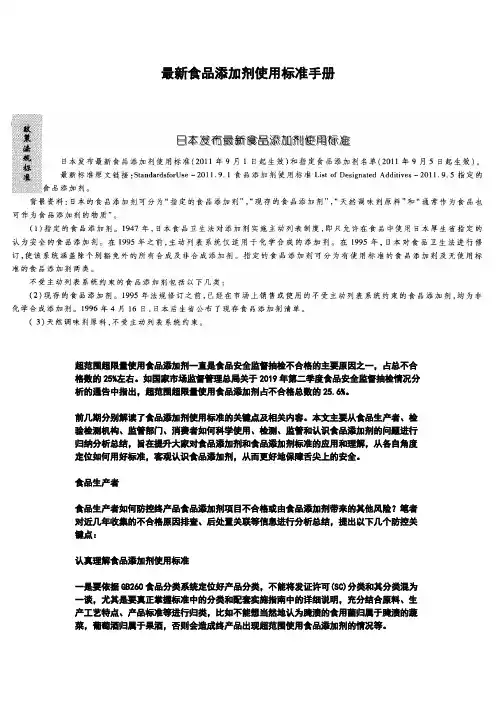
最新食品添加剂使用标准手册超范围超限量使用食品添加剂一直是食品安全监督抽检不合格的主要原因之一,占总不合格数的25%左右。
如国家市场监督管理总局关于2019年第二季度食品安全监督抽检情况分析的通告中指出,超范围超限量使用食品添加剂占不合格总数的25.6%。
前几期分别解读了食品添加剂使用标准的关键点及相关内容。
本文主要从食品生产者、检验检测机构、监管部门、消费者如何科学使用、检测、监管和认识食品添加剂的问题进行归纳分析总结,旨在提升大家对食品添加剂和食品添加剂标准的应用和理解,从各自角度定位如何用好标准,客观认识食品添加剂,从而更好地保障舌尖上的安全。
食品生产者食品生产者如何防控终产品食品添加剂项目不合格或由食品添加剂带来的其他风险?笔者对近几年收集的不合格原因排查、后处置关联等信息进行分析总结,提出以下几个防控关键点:认真理解食品添加剂使用标准一是要依据GB260食品分类系统定位好产品分类,不能将发证许可(SC)分类和其分类混为一谈,尤其是要真正掌握标准中的分类和配套实施指南中的详细说明,充分结合原料、生产工艺特点、产品标准等进行归类,比如不能想当然地认为腌渍的食用菌归属于腌渍的蔬菜,葡萄酒归属于果酒,否则会造成终产品出现超范围使用食品添加剂的情况等。
二是要充分理解标准中几个关键点,常见问题是使用防腐剂时,只注意单个防腐剂不超量,而忽略了防腐剂比例之和不超过1的规定;还有就是疏忽了使用规定中的A.4,即表A.3规定了表A.2所例外的食品类别,这些食品类别使用添加剂时应符合表A.1的规定。
同时,这些食品类别不得使用表A.1规定的其上级食品类别中允许使用的食品添加剂,除非在表A.1中明确规定至该细类食品类别。
如葡萄酒中超范围使用了三氯蔗糖。
三是不关注食品添加剂使用的一些相关通告,如餐饮环节不得使用亚硝酸盐、馒头不得使用含铝添加剂等规定,仍有不少餐饮加工者不知晓。
尤其一些食品添加剂使用增补通告,需动态关注国家卫健委或国家食品安全风险评估中心网站。
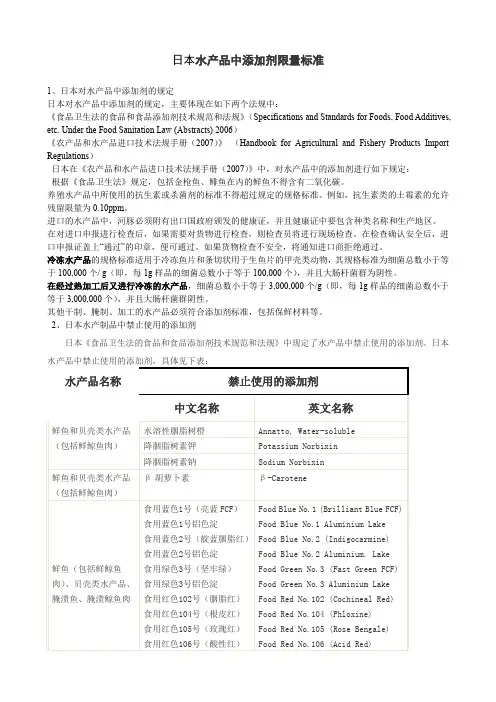
日本水产品中添加剂限量标准1、日本对水产品中添加剂的规定日本对水产品中添加剂的规定,主要体现在如下两个法规中:《食品卫生法的食品和食品添加剂技术规范和法规》(Specifications and Standards for Foods, Food Additives, etc. Under the Food Sanitation Law (Abstracts) 2006)《农产品和水产品进口技术法规手册(2007)》(Handbook for Agricultural and Fishery Products Import Regulations)日本在《农产品和水产品进口技术法规手册(2007)》中,对水产品中的添加剂进行如下规定:根据《食品卫生法》规定,包括金枪鱼、鲱鱼在内的鲜鱼不得含有二氧化碳。
养殖水产品中所使用的抗生素或杀菌剂的标准不得超过规定的规格标准。
例如,抗生素类的土霉素的允许残留限量为0.10ppm。
进口的水产品中,河豚必须附有出口国政府颁发的健康证,并且健康证中要包含种类名称和生产地区。
在对进口申报进行检查后,如果需要对货物进行检查,则检查员将进行现场检查。
在检查确认安全后,进口申报证盖上“通过”的印章,便可通过。
如果货物检查不安全,将通知进口商拒绝通过。
冷冻水产品的规格标准适用于冷冻鱼片和条切状用于生鱼片的甲壳类动物,其规格标准为细菌总数小于等于100,000个/ g(即,每1g样品的细菌总数小于等于100,000个),并且大肠杆菌群为阴性。
在经过热加工后又进行冷冻的水产品,细菌总数小于等于3,000,000个/g(即,每1g样品的细菌总数小于等于3,000,000个),并且大肠杆菌群阴性。
其他干制、腌制、加工的水产品必须符合添加剂标准,包括保鲜材料等。
2、日本水产制品中禁止使用的添加剂日本《食品卫生法的食品和食品添加剂技术规范和法规》中规定了水产品中禁止使用的添加剂。
日本。
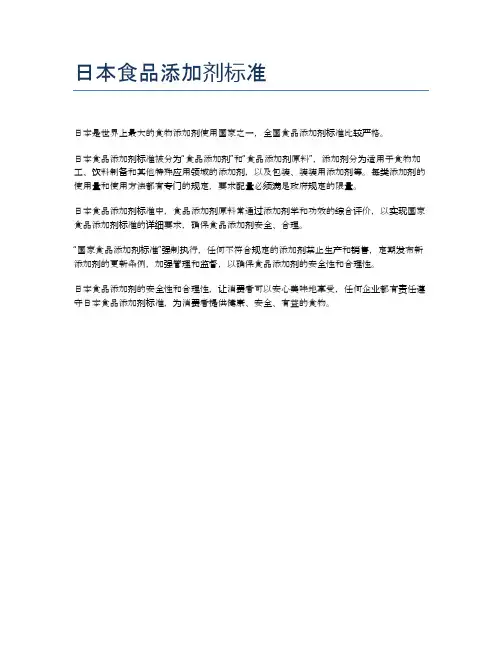
日本食品添加剂标准
日本是世界上最大的食物添加剂使用国家之一,全国食品添加剂标准比较严格。
日本食品添加剂标准被分为“食品添加剂”和“食品添加剂原料”,添加剂分为适用于食物加工、饮料制备和其他特殊应用领域的添加剂,以及包装、装装用添加剂等。
每类添加剂的使用量和使用方法都有专门的规定,要求配量必须满足政府规定的限量。
日本食品添加剂标准中,食品添加剂原料常通过添加剂学和功效的综合评价,以实现国家食品添加剂标准的详细要求,确保食品添加剂安全、合理。
“国家食品添加剂标准”强制执行,任何不符合规定的添加剂禁止生产和销售,定期发布新添加剂的更新条例,加强管理和监督,以确保食品添加剂的安全性和合理性。
日本食品添加剂的安全性和合理性,让消费者可以安心美味地享受,任何企业都有责任遵守日本食品添加剂标准,为消费者提供健康、安全、有益的食物。
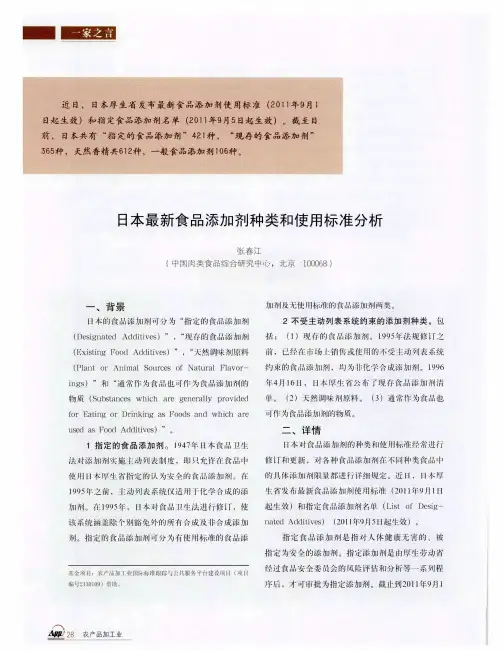
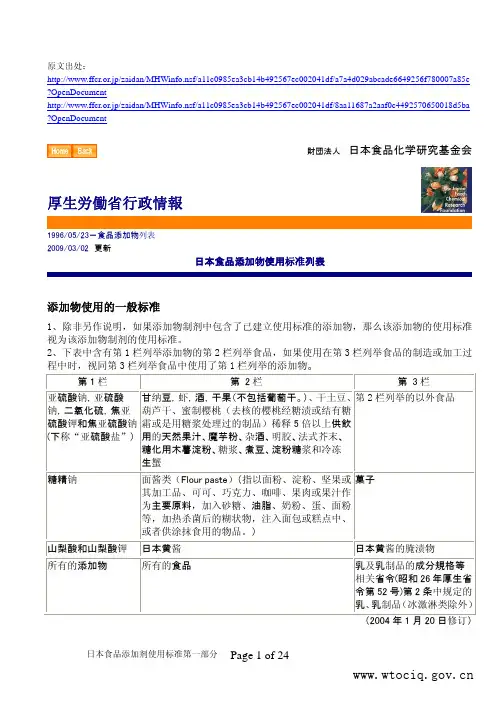
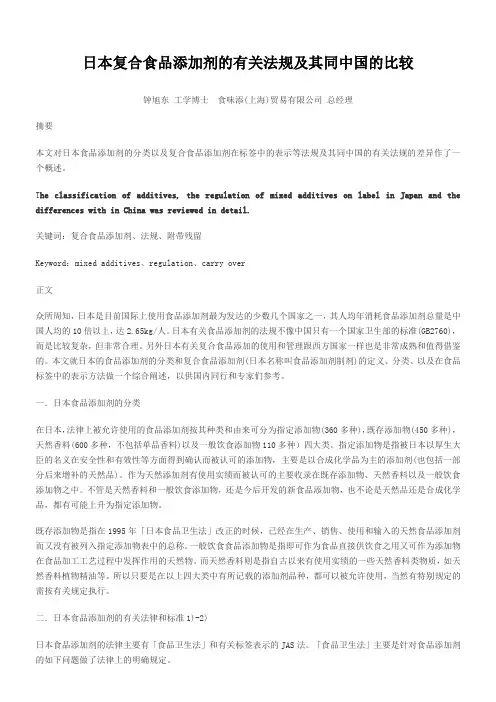
日本复合食品添加剂的有关法规及其同中国的比较钟旭东工学博士食味添(上海)贸易有限公司总经理摘要本文对日本食品添加剂的分类以及复合食品添加剂在标签中的表示等法规及其同中国的有关法规的差异作了一个概述。
T he classification of additives, the regulation of mixed additives on label in Japan and the differences with in China was reviewed in detail.关键词:复合食品添加剂、法规、附带残留Keyword:mixed additives、regulation、carry over正文众所周知,日本是目前国际上使用食品添加剂最为发达的少数几个国家之一,其人均年消耗食品添加剂总量是中国人均的10倍以上,达2.65kg/人。
日本有关食品添加剂的法规不像中国只有一个国家卫生部的标准(GB2760),而是比较复杂,但非常合理。
另外日本有关复合食品添加的使用和管理跟西方国家一样也是非常成熟和值得借鉴的。
本文就日本的食品添加剂的分类和复合食品添加剂(日本名称叫食品添加剂制剂)的定义、分类、以及在食品标签中的表示方法做一个综合阐述,以供国内同行和专家们参考。
一.日本食品添加剂的分类在日本,法律上被允许使用的食品添加剂按其种类和由来可分为指定添加物(360多种),既存添加物(450多种),天然香料(600多种,不包括单品香料)以及一般饮食添加物110多种)四大类。
指定添加物是指被日本以厚生大臣的名义在安全性和有效性等方面得到确认而被认可的添加物,主要是以合成化学品为主的添加剂(也包括一部分后来增补的天然品)。
作为天然添加剂有使用实绩而被认可的主要收录在既存添加物、天然香料以及一般饮食添加物之中。
不管是天然香料和一般饮食添加物,还是今后开发的新食品添加物,也不论是天然品还是合成化学品,都有可能上升为指定添加物。
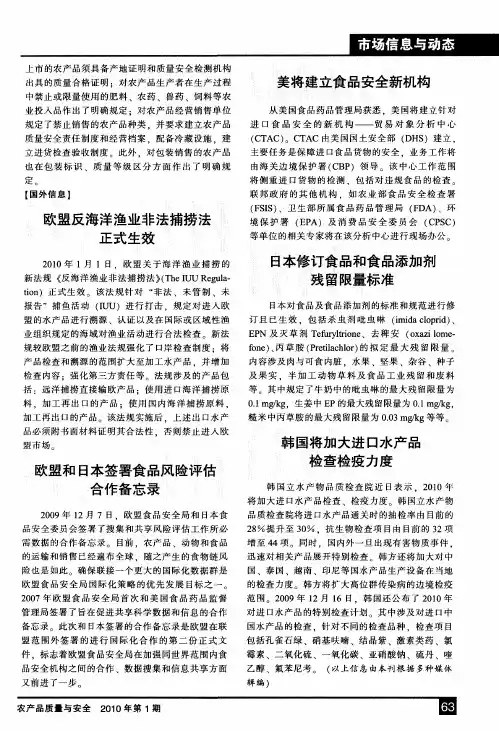
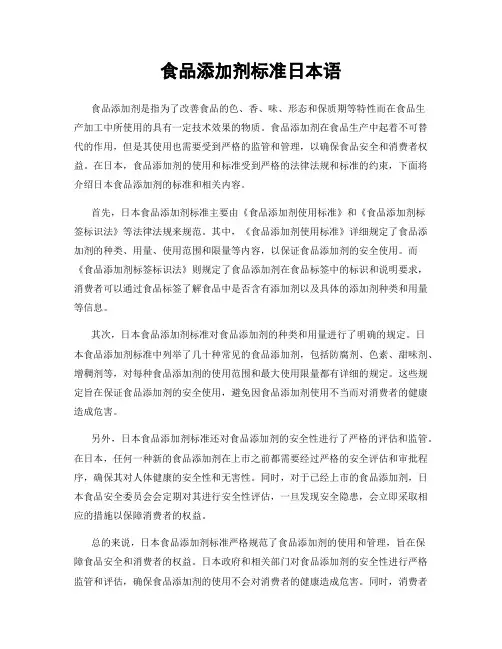
食品添加剂标准日本语食品添加剂是指为了改善食品的色、香、味、形态和保质期等特性而在食品生产加工中所使用的具有一定技术效果的物质。
食品添加剂在食品生产中起着不可替代的作用,但是其使用也需要受到严格的监管和管理,以确保食品安全和消费者权益。
在日本,食品添加剂的使用和标准受到严格的法律法规和标准的约束,下面将介绍日本食品添加剂的标准和相关内容。
首先,日本食品添加剂标准主要由《食品添加剂使用标准》和《食品添加剂标签标识法》等法律法规来规范。
其中,《食品添加剂使用标准》详细规定了食品添加剂的种类、用量、使用范围和限量等内容,以保证食品添加剂的安全使用。
而《食品添加剂标签标识法》则规定了食品添加剂在食品标签中的标识和说明要求,消费者可以通过食品标签了解食品中是否含有添加剂以及具体的添加剂种类和用量等信息。
其次,日本食品添加剂标准对食品添加剂的种类和用量进行了明确的规定。
日本食品添加剂标准中列举了几十种常见的食品添加剂,包括防腐剂、色素、甜味剂、增稠剂等,对每种食品添加剂的使用范围和最大使用限量都有详细的规定。
这些规定旨在保证食品添加剂的安全使用,避免因食品添加剂使用不当而对消费者的健康造成危害。
另外,日本食品添加剂标准还对食品添加剂的安全性进行了严格的评估和监管。
在日本,任何一种新的食品添加剂在上市之前都需要经过严格的安全评估和审批程序,确保其对人体健康的安全性和无害性。
同时,对于已经上市的食品添加剂,日本食品安全委员会会定期对其进行安全性评估,一旦发现安全隐患,会立即采取相应的措施以保障消费者的权益。
总的来说,日本食品添加剂标准严格规范了食品添加剂的使用和管理,旨在保障食品安全和消费者的权益。
日本政府和相关部门对食品添加剂的安全性进行严格监管和评估,确保食品添加剂的使用不会对消费者的健康造成危害。
同时,消费者也可以通过食品标签了解食品中是否含有添加剂以及具体的添加剂种类和用量等信息,以便做出明智的消费选择。
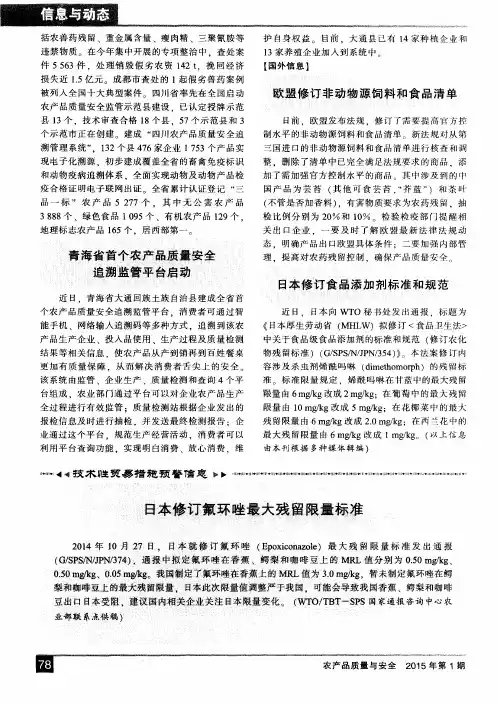
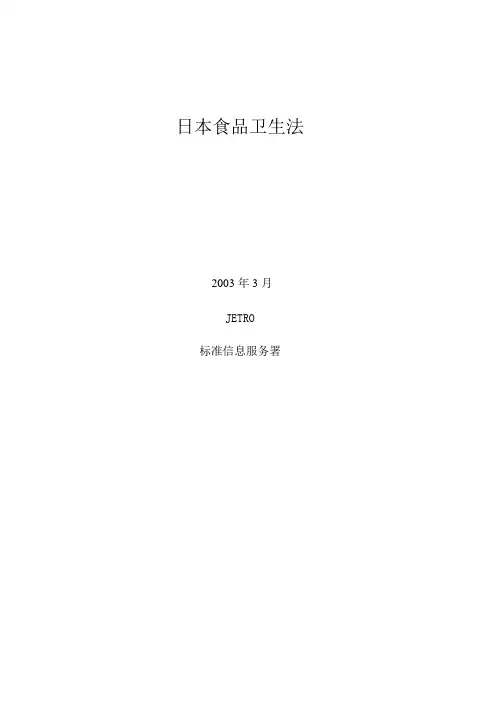
现有的食品添加剂下表所列是1996年4月16日日本后生省公布的现有食品添加剂清单。
表中所列的任何一种食品添加剂和任何含有上述食品添加剂的食品或制剂,由于有对日本食品卫生法进行修订的临时措施,均不受该法第6条规定的约束。
因此,继续允许针对这些食品添加剂等而从事的经销、制造、进口等营销活动。
注:1)为便于使用,下表按字母顺序排列。
2)天然调味品,以及通常即可作为食品也可作为食品添加剂的物质,不属卫生法第6条规定的管制范围,因此,下表不包括这两类物质。
1.Absinth extract 苦艾提取物一种主要由从完整的苦艾草中获取的倍半萜构成的物质。
2. α-Acetolactate decarboxylase α-已酰乳酸脱羧酶3.N-Acetylglucosamine N-已酰基葡糖胺4.Achromopeptidase 消色肽酶5.Acid clay 酸性黏土6.Acid phosphatase 酸性磷酸酶7.Actinidine 猕猴桃碱8.Activated acid clay 活性酸性黏土9.Active carbon 活性炭一种通过炭化和活化含碳物质获取的物质。
10.Acylase 酰酶11.5'-Adenylic acid 5'-酰苷一磷酸12.Aeromonas gum 气单胞菌胶主要由通过气单胞菌属细菌培养液获取的多聚糖构成的一种物质。
13.Agarase 琼脂水解酶14.Agrobacterium succinoglycan 土壤杆菌属主要由通过土壤杆菌属细菌培养液获取的succinoglycan构成的一种物质。
15.L-Alanine L-丙氨酸16.Alginate lyase 藻酸盐裂解酶17.Alginic acid 藻酸18.Alkanet colour 紫草红色素主要由紫草根提取的紫草素构成的一种物质。
19.Almond gum[Cedo gum] 苦扁桃胶主要由杏树分泌物中提取的多聚糖构成的一种物质。
前ページへ *記載のない場合は対象食品の規制はない。
使用できる食品等*使用量等の最大限度チオエーテル類(ただし、毒性が激しいと一般に認められるものを除く。
)チオール類(別名チオアルコール類)(ただし、毒性が激しいと一般に認められるものを除く。
)調味料強化剤デカナールデカノールデカン酸エチル鉄クロロフィリンナトリウム着色料 5,6,7,8-テトラヒドロキノキサリン2,3,5,6-テトラメチルピラジンチーズデヒドロ酢酸としてバター0.50g/kgマーガリンテルピネオールテルペン系炭化水素類デンプングリコール酸ナトリウム糊料2.00%銅としてこんぶ(無水物)0.15g/kg 野菜類又は果実類の貯蔵品0.10g/kg シロップ0.064g/kg チューインガム0.050g/kg 着色料(化学的合成品を除く)着色料香料香料L-テアニン 使用基準香料品名(日文)分類香料デヒドロ酢酸ナトリウム保存料銅クロロフィリンナトリウム着色料魚肉ねり製品(魚肉すり身を除く)0.040g/kgあめ類0.020g/kg チョコレート生菓子(菓子パンを除く)みつ豆缶詰又はみつ豆合成樹脂製容器包装詰中の寒天0.00040g/kg銅としてこんぶ(無水物)0.15g/kg 野菜類又は果実類の貯蔵品0.10g/kg チューインガム0.050g/kg 魚肉ねり製品(魚肉すり身を除く)0.030g/kg 生菓子(菓子パンを除く)0.0064g/kg チョコレート0.0010g/kg みつ豆缶詰又はみつ豆合成樹脂製容器包装詰中の寒天0.00040g/kg トコフェロール酢酸エステル強化剤保健機能食品150mg未満/当該食品1日摂取目安量(a-トコフェロールとして)d -a-トコフェロール酢酸エステル強化剤保健機能食品150mg未満/当該食品1日摂取目安量(a-トコフェロールとして)DL-トリプトファン調味料L-トリプトファン強化剤2,3,5-トリメチルピラジン香料DL-トレオニン調味料L-トレオニン強化剤ナイシンAを含むポリペプチドとして食肉製品チーズ(プロセスチーズを除く)0.0064g/kg銅クロロフィル着色料dl -a-トコフェロール(ビタミンE)酸化防止剤ナイシン保存料0.0125g/kgホイップクリーム類(乳脂肪分を主成分とする食品を主要原料として泡立てたもの)ソース類ドレッシングマヨネーズプロセスチーズ洋菓子卵加工品味噌洋生菓子(穀類及びでん粉を主原料としたもの)0.0030g/kgナタマイシン製造用剤ナチュラルチーズ(ハード及びセミハードの表面部分に限る)0.020g/kg未満ニコチン酸強化剤ニコチン酸アミド製造用剤漂白剤保存料酸化防止剤かんぴょう 5.0g/kg未満乾燥果実(干しぶどうを除く) 2.0g/kg未満干しぶどう 1.5g/kg未満コンニャク粉0.90g/kg未満乾燥じゃがいもゼラチンディジョンマスタード0.010g/kg0.00625g/kg0.0050g/kg ナトリウムメトキシド製造用剤二酸化硫黄二酸化硫黄としての残存量0.50g/kg未満果実酒(果実酒の製造に用いる酒精分1容量パーセント以上を含有する果実搾汁およびこれを濃縮したものを除く)雑酒キャンデッドチェリー糖蜜糖化用タピオカでんぷん0.25g/kg未満水あめ0.20g/kg未満天然果汁(5倍以上に希釈して飲用に供するもの)0.15g/kg未満甘納豆煮豆えび冷凍生かにその他の食品(キャンデッドチェリーの製造に用いるさくらんぼ、ビール製造に用いるホップ並びに果実酒に用いる果汁、酒精分1容量パーセント以上を含有する果実搾汁およびこれを濃縮したものを除く)二酸化塩素小麦粉処理剤小麦粉0.30g/kg未満0.10g/kg未満0.10g/kg未満(そのむき身につき)0.030g/kg未満0.35g/kg未満2.00%(ケイ酸カルシウムと併用する場合は、それぞれの使用量の和)二酸化炭素製造用剤 乳酸酸味料 乳酸カルシウム強化剤カルシウムとして1.0%(特別用途表示の食品を除く)乳酸鉄強化剤 乳酸ナトリウム調味料 γ-ノナラクトン香料 ノルビキシンカリウムノルビキシンナトリウムバニリン香料 パラオキシ安息香酸イソプチル パラオキシ安息香酸としてパラオキシ安息香酸イソプロピルしょう油0.25g/L パラオキシ安息香酸エチル果実ソース0.20g/kg パラオキシ安息香酸ブチル酢0.10g/L 清涼飲料水シロップ果実及び果菜の表皮0.012g/kgパラメチルアセトフェノン香料 調味料強化剤バレルアルデヒド香料 パントテン酸カルシウム強化剤カルシウムとして1.0%(特別用途表示の食品を除く)パントテン酸ナトリウム強化剤 ビオチン強化剤保健機能食品L-ヒスチジン塩酸塩ビスベンチアミン二酸化ケイ素製造用剤 微粒二酸化ケイ素製造用剤二酸化チタン着色料着色料 保存料強化剤パラオキシ安息香酸プロピル0.10g/kg L-バリン ビタミンAビタミンA脂肪酸エステルビタミンA油(油性ビタミンA脂肪酸エステル)ヒドロキシシトロネラールヒドロキシシトロネラールジメチルアセタールヒドロキシプロピルセルロース製造用剤ヒドロキシプロピルメチルセルロース製造用剤ピペリジン香料ピペロナール香料ピペロニルブトキシド防虫剤穀類0.024g/kg氷酢酸酸味料 ピラジン香料ピリドキシン塩酸塩強化剤 ピロ亜硫酸カリウム漂白剤二酸化硫黄としての残存量保存料かんぴょう 5.0g/kg未満酸化防止剤乾燥果実(干しぶどうを除く)2.0g/kg未満干しぶどう 1.5g/kg未満コンニャク粉0.90g/kg未満乾燥じゃがいもゼラチンディジョンマスタード果実酒(果実酒の製造に用いる酒精分1容量パーセント以上を含有する果実搾汁およびこれを濃縮したものを除く)雑酒キャンデッドチェリー糖蜜糖化用タピオカでんぷん0.25g/kg未満強化剤 香料 ピロ亜硫酸ナトリウム0.50g/kg未満0.35g/kg未満0.30g/kg未満水あめ0.20g/kg未満天然果汁(5倍以上に希釈して飲用に供するもの)0.15g/kg未満甘納豆煮豆えび冷凍生かにその他の食品(キャンデッドチェリーの製造に用いるさくらんぼ、ビール製造に用いるホップ並びに果実酒に用いる果汁、酒精分1容量パーセント以上を含有する果実搾汁およびこれを濃縮したものを除く)ピロリジン香料ピロリン酸四カリウム製造用剤 製造用剤強化剤ピロリン酸二水素二ナトリウム製造用剤 ピロリン酸第二鉄強化剤ピロリン酸四ナトリウム製造用剤 調味料強化剤フェニル酢酸イソアミルフェニル酢酸イソブチルフェニル酢酸エチル2-(3-フェニルプロピル)ピリジンフェネチルアミン0.10g/kg未満0.10g/kg未満(そのむき身につき)0.030g/kg未満ピロリン酸二水素カルシウムカルシウムとして1.0%(特別用途表示の食品を除く)L-フェニルアラニン 香料 フェノールエーテル類(ただし、毒性が激しいと一般に認められるものを除く。